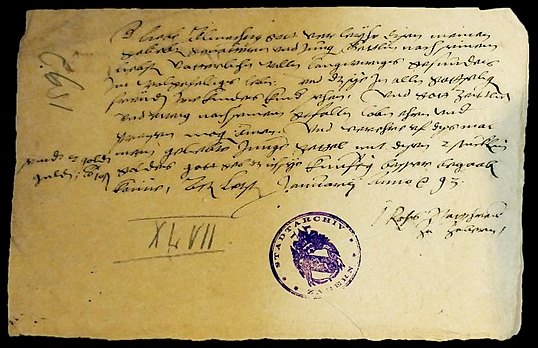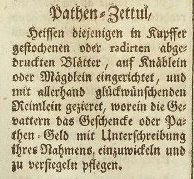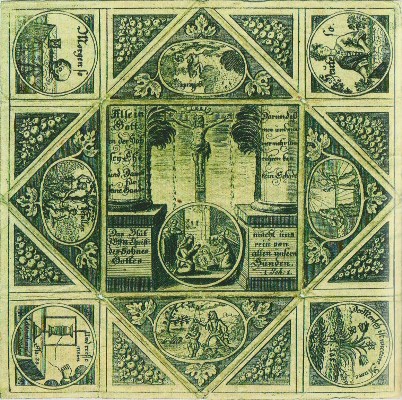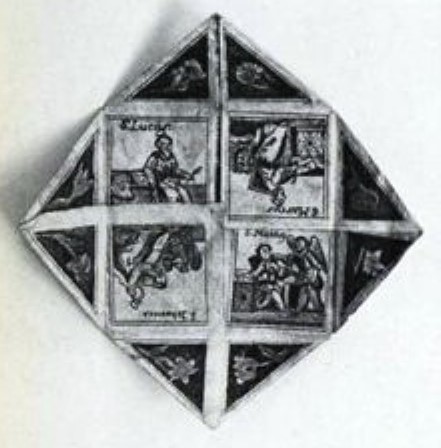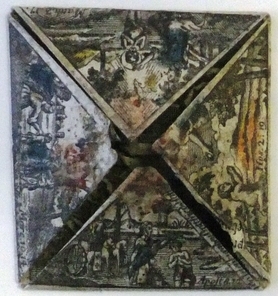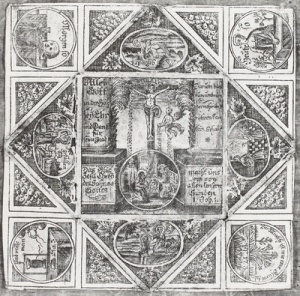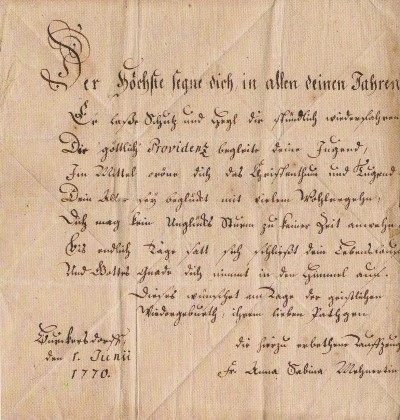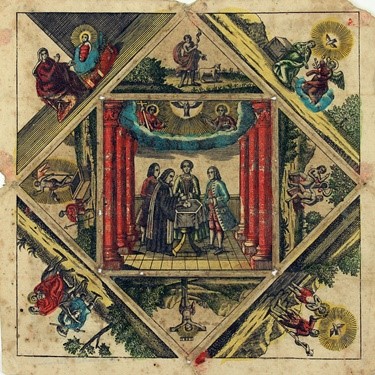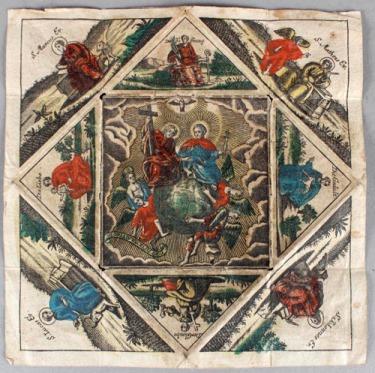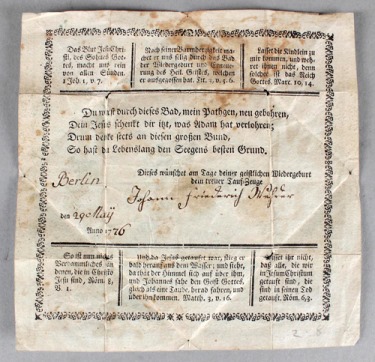| The Public Paperfolding History Project
Last updated 9/1/2024 x |
|||||||
| Patenbriefs / Taufbriefs / Godparent Letters | |||||||
This page is being used to collect information about the history of folded Godparent Letters, which go under various names such as Patenbriefs, Göttelbriefs, Taufbriefs etc. Please contact me if you know any of this information is incorrect or if you have any other important information that should be added. Thank you. In articles on paperfolding history folded Patenbriefs are sometimes referred to as baptismal certificates. Godparent letter is probably a better translation. ********** Introduction Three types of folded Patenbrief are known: 1, Those printed on oblong paper and folded into a rectangular packet (evidenced from 1698 though possibly earlier) 2, Those printed on square paper and folded into a double blintz form (evidenced from 1757 though possibly earlier). 3, Those printed on square paper and folded into the form of a puzzle purse (evidenced from 1770 though possibly earlier). *** According to the Pennsylvania German Blog of May 2016 , 'The Taufbrief or baptismal letter, also known as a Taufwunsch or baptismal wish, Taufzedel, Taufzettel, Taufzeddul or baptismal note, and Göttelbrief or godmother letter ... bears witness to the relationship and responsibilities between godparents and the consecrated infant. This was to be a lasting memory to the child of its dedication to God on that day, and the desire of its sponsor(s) that it might continue to thrive in its relationship with its Creator as it grew to adulthood. It always contains the names of the sponsors, and often the child’s first name, and the date of baptism. It may or may not contain the church affiliation and place, child’s last name, and date of birth. It almost never contains the parents’ names.' and 'publishers offered and marketed (Patenbriefs) through local bookstores, as well as itinerant book sellers who canvassed the countryside with their wares. Some of the better known were Reinholden Printers in Leipzig; J. Balzer and E. W. Buchheister in Breslau; J. H. Hierthes in Weissenburg; Johann Andreas Endter in Nürnberg; F. J. Oberthür in Straßburg; and Gottfried Hoffmann in Waldenburg, who printed baptismal greetings from 1756 on, and whose heirs continued to do so into the beginning of the nineteenth century.' *** According to a blogpost from the Hennebergisches Museum Kloster Veßra, roughly translated, 'The sponsorship letter not only included the godparent's wish of happiness and blessing, it was often also a birth certificate and baptismal certificate ... In addition, the folding letter formed the wrapping for the sponsorship money (Göttelgeld or Patengeld), which was handed over as a lucky penny for the baptized and could not be spent ... The custom around the godfather letter is rich. In popular belief, the letter provided a special protective force for the child. Occasionally, the letter also contained breadcrumbs and salt, seeds or, for girls, a threaded sewing needle as symbolic gifts and happy omens for the further life of the child ... Due to their great memory value, sponsorship letters, often placed in a Bible or hymnbook, were well preserved.' *** The entry for 'Patten-Zettul' in 'Nutzbares, galantes und curiöses Frauenzimmer-Lexicon' tells us that in 1715 'The godparents ... usually wind something around to make them secure.' The rectangular packet form and the puzzle purse form are already secure packages so I presume that this remark applies to patenbriefs folded into a double blintz form. *** According to 'Piety and Protocol in Folk Art: Pennsylvania German Fraktur Birth and Baptismal Certificates ' by Frederick S Weiser, 'The earliest known patenbrief comes from comes from a Catholic ceremony at Saverne (Zabern) in Alsace and is dated 1593. The next earliest is dated 1686, from Rostock, northern Germany, and is Protestant.' *** An article about a Taufenpatenbrief or Godparent’s letter from 1781 gives two, presumably, useful references, although I have not been able to find either online at present. Adolf Spamer, 'Das kleine Andachtsbild', vom XIV. bis zum XX. Jahrhundert. Mit 314 Abbildungen auf 218 Tafeln und 53 Abbildungen im Text (Munchen, F. Bruckmann, 1930). RECAP Oversize N7640.S78q p. 242. Michael Twyman’s chapter on ‘Baptismal Papers’ in: Maurice Rickards (1919-1998), 'The Encyclopedia of Ephemera' edited and completed by Michael Twyman (GARF Oversize NC1280 .R52 2000q) ********** Chronology 1593 This is the patenbrief from Saverne in Alsace dated 1593, said to be the oldest in existence. To judge purely from the photograph, it does not appear to have been folded in any way.
According to a blogpost from the Hennebergisches Museum Kloster Veßra, roughly translated, 'Already the oldest surviving patent letter from 1593 from Zabern in Alsace mentions in the text the so-called Göttelgeld (godfather's money), which it contained.' ********** 1686 I have not been able to find an image of the patenbrief from Rostock, dated 1686. ********** 1698 This Calvinist patenbrief is dated 1698. The creases show that it was once folded to create a rectangular package.
********** 1715 A useful definition of a 'Patten-Zettul', another variation of the name, appeared in 'Nutzbares, galantes und curiöses Frauenzimmer-Lexicon' (A Useful, Noble, and Curious Lexicon for Women) by Amaranthes (pseudonym of Gottlieb Siegmund Corvinus), which was published in Leipzig in 1715.
In English: 'Patten-Zettul are those printed papers with copper etchings or engravings intended for a baby boy or girl, and are decorated with all kinds of rhyming congratulatory verses. The godparents sign their names on the sheets; tuck their gifts or sponsor money into them; and usually wind something around to make them secure.' ********** 1726? This Patenbrief appears in 'Folded Beauty' by Joan Sallas, which was published by Jong Ie Nara in 2018. The caption states that it dates from 1726. The interior, which would confirm the date, is not shown. The date, however, seems too early for a pre-printed Patenbrief of this type, and it seems possible that this date is a typographical error. (A very similar design, said to be dated 1765, appears below.)
********** 1757 A photograph of a Patenbrief folded into a double blintz form and said to date from 1757 appears in 'Papier und Form' by Kurt Londenberg, which was published by Scherpe Verlag in Krefeld in 1963.
********** 1763 This example of a patenbrief folded into a double blintz form is dated 1763 and is in the collection of the Museum Europäischer Kulturen, Staatliche Museen zu Berlin, Berlin. See here.
********** 1765 The image below shows the exterior surface of a patenbrief from 1765, from the collection of the Staatliche Kunstsammlungen in Dresden, in an unfolded state. It would once have been folded into a double blintz form.
********** 1770 This handwritten Patenbrief appears in 'Folded Beauty' by Joan Sallas, which was published by Jong Ie Nara in 2018. The arrangement of the creases show that it was folded into the form of a Puzzle Purse.
********** 1774 These images are of the cover and interior of a pre-printed patenbrief from 1774. The crease lines show that it also would have been folded into a double blintz form.
********** 1776 A similar design from from Berlin dated 1776.
********** |
|||||||
